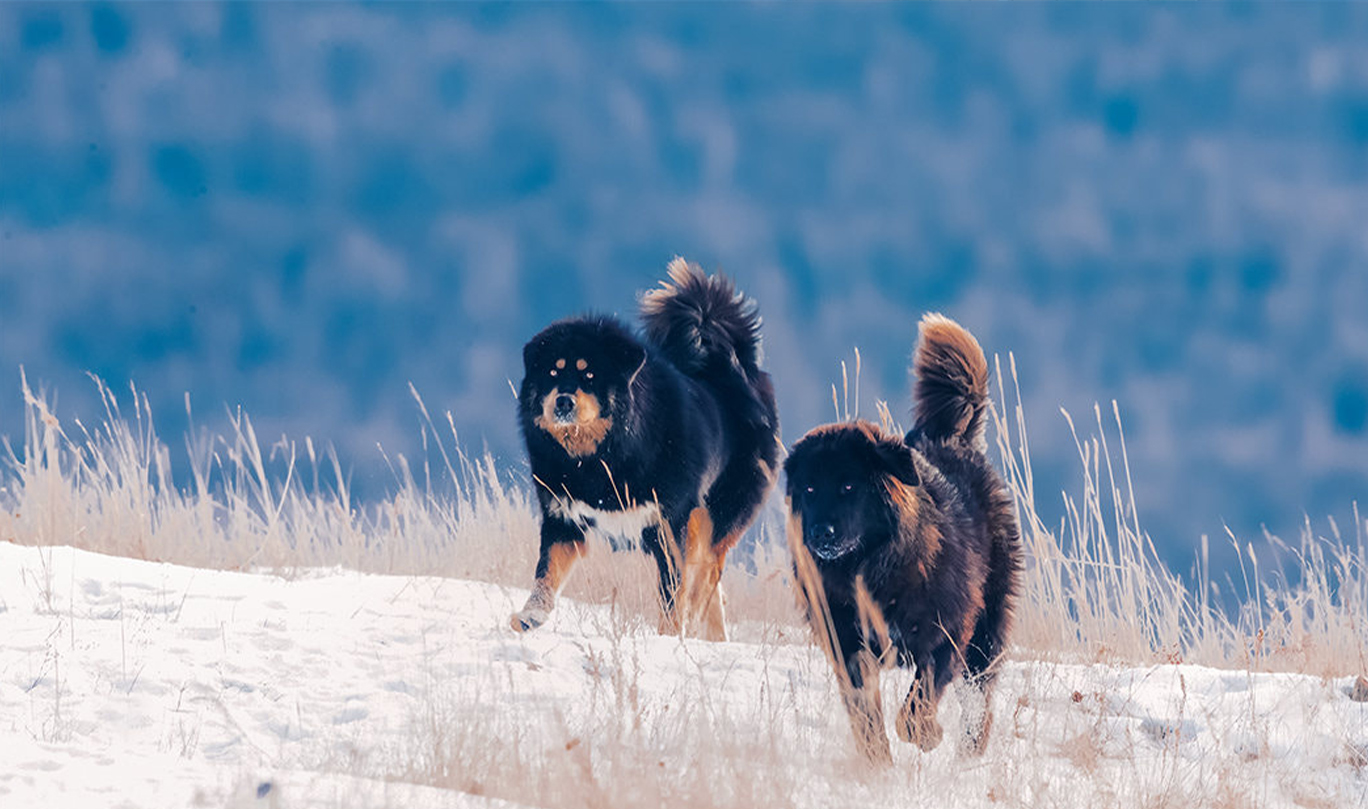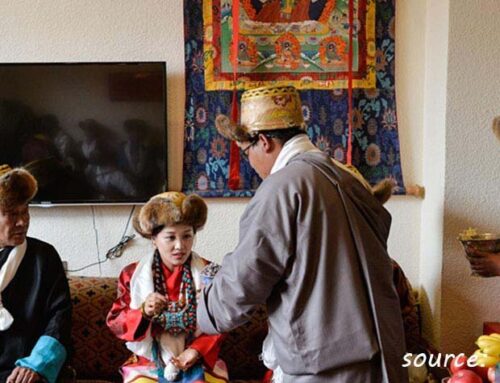Legends and Origin of the Tibetan Mastiff: According to ancient Tibetan legends, the Tibetan Mastiff is not merely a guardian on Earth but a celestial being with a divine purpose. In times of severe winters and plagues, the Tibetan people believed that living Buddhas descended from the heavens, riding on the backs of giant Tibetan Mastiffs. These majestic dogs were more than mere companions; they were the harbingers of salvation, draped in cloaks and wielding sacred bells. The symbolism of the living Buddhas on these colossal canines was profound, signifying a supernatural intervention that transcended the earthly realm.
Cloaked in mystery and revered as emissaries from the celestial realms, these Tibetan Mastiffs played a pivotal role in altering the course of natural disasters. The legends narrate a mesmerizing tale where the divine presence of these dogs had the power to melt the icy grip of severe winters, dispel plagues that afflicted the land, and breathe life back into the desolate terrain. The reverence bestowed upon these celestial canines by the Tibetan people echoes through generations, as the stories of their supernatural intervention continue to be passed down, solidifying the Tibetan Mastiff’s status as more than a mere earthly companion but a revered and divine guardian.

Heavenly Guardians
Divine Intervention
In accordance with ancient Tibetan legends, the Tibetan Mastiff holds a position of profound significance as a celestial emissary believed to descend from the heavens during times of severe winters and plagues. According to these captivating tales, living Buddhas, adorned in cloaks and wielding sacred bells, would astride the backs of giant Tibetan Mastiffs, manifesting as divine entities sent to bring salvation to the beleaguered people. The sheer celestial presence of these majestic dogs was said to wield transformative powers, capable of melting icy landscapes, dispelling pervasive plagues, and breathing life back into the desolate terrain. This extraordinary intervention earned the Tibetan Mastiffs a revered place in the hearts and minds of the Tibetan people, solidifying their status as heavenly guardians and endowing them with a profound sense of esteem within the cultural and spiritual fabric of Tibetan society.
Religious Significance
The religious significance of Tibetan Mastiffs is deeply intertwined with the rich tapestry of Tibetan culture, particularly its profound connection to Buddhism. In the Tibetan region, where Buddhism holds immense sway, these majestic dogs transcend their earthly roles as mere protectors of herdsmen. Instead, they take on a more spiritual dimension, evolving into sacred companions with a divine mission. Viewed through the lens of Tibetan Buddhism, Tibetan Mastiffs are perceived not only as loyal guardians but as emissaries sent to safeguard the people. The mystical aura surrounding these dogs is heightened by their association with the sacred teachings of Buddhism, emphasizing their role as more than earthly beings. This connection underscores how deeply embedded the influence of Buddhism is in Tibetan culture, where even the loyal and protective nature of Tibetan Mastiffs is elevated to a spiritual plane.
The Leopard Encounter: A Tale of Bravery and Loyalty
Hunter's Salvation
In yet another captivating legend, a Tibetan hunter found himself in a perilous situation in the desolate expanse of remote mountains. The threat looming over him was none other than a fierce leopard, its predatory instincts ready to pounce. In the face of imminent danger, with no time to draw his bow or devise a plan, the hunter's fate seemed bleak. However, in a miraculous turn of events, a colossal dog, seemingly descending from the heavens themselves, made a dramatic appearance. The majestic canine fearlessly positioned itself between the hunter and the menacing leopard, exhibiting a courage that could only be described as divine. The ensuing battle was fierce, as the giant dog, with thunderous roars, confronted the leopard, providing the hunter with a precious window of opportunity. Seizing the moment, the grateful hunter swiftly dispatched the threat with his sword. Overwhelmed with gratitude for this extraordinary act of intervention, the hunter decided to bring the celestial dog home with him. This pivotal moment marked the initiation of a profound and enduring companionship, where the Tibetan Mastiff became not just a guardian but a cherished and loyal ally in the hunter's life.
Guardianship and Gratitude
In the aftermath of the perilous encounter between the Tibetan hunter and the leopard, an unbreakable bond formed between the man and his Tibetan Mastiff. The hunter, overwhelmed with gratitude for the dog's heroic intervention, welcomed the giant canine into his life. From that pivotal moment, the Tibetan Mastiff transcended its role as a mere companion, evolving into an indispensable guardian for the hunter's herds and homestead. The loyalty exhibited by the Tibetan Mastiff was not just a fleeting gesture; it became a profound and enduring commitment to the hunter's safety and well-being. In the vast landscapes of the Tibetan mountains, the dog stood vigilant, a formidable presence that deterred any potential threats. The courageous act against the leopard was not a singular event but rather the initiation of a lifelong partnership marked by shared trust and mutual guardianship. This tale, etched into the fabric of Tibetan folklore, sheds light on the remarkable courage and unwavering loyalty that define the Tibetan Mastiff, elevating it beyond a mere protector to a devoted and cherished companion in the hunter's journey through the rugged terrains of life.
Religious Connection: Buddhism Influence and Sacred Companions
Buddhism's Impact
Buddhism's impact on the Tibetan Mastiff is profound, as the breed's association with divine intervention seamlessly aligns with the deep reverence for Buddhism in the Tibetan region. The influential role of Buddhism in Tibetan culture is unmistakable, permeating various aspects of life, including the perception of these majestic dogs. It goes beyond considering Tibetan Mastiffs as mere protectors; instead, they are viewed as envoys from Heaven, entrusted with a sacred mission to safeguard the well-being of the herdsmen. The spiritual connection between Buddhism and the Tibetan Mastiff enhances the mythical aura surrounding these dogs, elevating them to a status beyond ordinary guardians and positioning them as revered beings with a divine purpose in the intricate tapestry of Tibetan beliefs and traditions.
Envoys from Heaven
Envoys from Heaven, Tibetans hold Tibetan Mastiffs in high regard, considering them as messengers from the celestial realms. The deep bond between these dogs and the Tibetan people is seen as a spiritual connection, emphasizing their role as guardians with a divine purpose. This reverence is rooted in the belief that Tibetan Mastiffs are not merely earthly companions but rather emissaries sent from higher realms to protect and guide the people. The spiritual significance attached to these majestic dogs goes beyond their physical attributes and protective instincts; it underscores a profound connection between the earthly realm and the sacred, highlighting the integral role Tibetan Mastiffs play in the spiritual fabric of Tibetan culture. As guardians with a divine purpose, these dogs symbolize a bridge between the tangible and the ethereal, embodying the enduring connection between the Tibetan people and the celestial forces they hold in high esteem.
Historical Evolution: Early Tibetan Settlements and Adaptation to Plateau Life
Stone Age Ancestors
In the Stone Age, the ancestors of the Tibetan people resided along the Yarlung Zangbo River, initially adopting a hunter-gatherer lifestyle. Over time, they transitioned to settled agricultural practices after migrating north and east, where they interacted and intermingled with nomadic tribes such as the Xirong and Qiang. This crucial historical development not only shaped their way of life but laid the foundational framework for the Tibetan people as we recognize them in the present day.
Adaptation to Harsh Conditions
Surviving on the Qinghai-Tibet Plateau, with an average altitude of over 3,000 m, demanded a profound adaptation to severe natural conditions. The early Tibetan settlers, engaged in farming, hunting, and pasturing, faced not only the challenges posed by the harsh climate but also the constant threats from formidable predators such as wolves, bears, and leopards. In this demanding environment, the necessity for protective measures became urgent. The herdsmen, realizing the need for reliable guardians, embarked on a journey of evolution that ultimately gave rise to the Tibetan Mastiff. This breed, shaped by the unforgiving conditions of the plateau, became not just a companion but a crucial element in the survival strategies of the Tibetan people, standing as a testament to their resilience in the face of adversity.
Tibetan Mastiff Characteristics
Survival of the Fittest
In response to the cruel conditions of the plateau, primitive dog breeds underwent a remarkable process of evolution, giving rise to the larger, tougher, fiercer, and more intelligent Tibetan Mastiffs. Faced with the challenges of survival, these dogs developed an instinct to follow herdsmen during food shortages, capitalizing on opportunities to feed on deceased cattle and other offal. This adaptive behavior not only contributed to their physical robustness but also paved the way for their domestication. Swiftly learning the intricacies of guarding nomadic camps and protecting livestock herds, Tibetan Mastiffs seamlessly integrated into the fabric of Tibetan families, becoming indispensable members whose loyalty and protective instincts played a vital role in the survival of both the herdsmen and their flocks.
Guardians of the Nomadic Life
Tibetan Mastiffs developed distinct characteristics to withstand the challenges of their environment, with their bravery and aggressiveness making them formidable guardians against predators such as wolves, bears, and leopards. This breed's symbiotic relationship with herdsmen became essential for survival in the nomadic lifestyle, where the harsh climate and threats from wildlife necessitated a loyal and protective companion. The Tibetan Mastiff's evolution through natural selection and domestication tailored them into not just dogs but reliable members of nomadic families, ensuring the safety of both the herdsmen and their flocks in the unforgiving landscapes of the Qinghai-Tibet Plateau. Their intelligence, fierceness, and unwavering loyalty contributed to the endurance of the Tibetan people in the face of the myriad challenges posed by their nomadic existence.
The Hunter and His Dog: Rescue Story and Enduring Bond
Courageous Intervention
In a courageous intervention, a Tibetan hunter found himself in a life-threatening situation, facing a leopard attack. It is in this critical moment that the exceptional bravery of Tibetan Mastiffs comes to light. With a thunderous roar, the Mastiff leaped into action, engaging in a fierce battle with the predatory leopard. This act of valor not only provided the hunter with a vital opening to dispatch the imminent threat but also forged a profound connection between man and dog. In a gesture of gratitude, the hunter took the Tibetan Mastiff home, marking the beginning of an enduring bond that transcends the ordinary. This narrative encapsulates the essence of the Tibetan Mastiff's loyalty, protective instincts, and the remarkable role they play in the lives of the Tibetan people.
Companionship and Guardianship
From that day forward, the Tibetan Mastiff seamlessly integrated into the hunter's life, becoming an integral and cherished part of his daily existence. The steadfast companionship provided by the Mastiff went beyond a mere association; it became a bond woven with loyalty and protective instincts. The dog, once a divine savior in the face of danger, now stood as a constant presence, guarding not only the herds and homestead but also the emotional well-being of its human companion. This narrative beautifully captures the essence of the Tibetan Mastiff's role, transcending the conventional notion of a pet and evolving into a treasured member of Tibetan families. Their significance extends beyond mere utility; it is a testament to the enduring connection between these majestic creatures and the people they serve, symbolizing a companionship and guardianship that goes beyond the ordinary.
Tibetan People's Reverence: Cultural Importance and Symbolic Meaning
Esteemed Protectors
Esteemed Protectors, Tibetan Mastiffs continue to be held in high regard by the Tibetan people, seen as esteemed protectors with a rich cultural significance. Their role as guardians during times of crisis and their unwavering loyalty to herdsmen have elevated them to a revered status in Tibetan culture. This elevated status goes beyond practical utility; it is deeply rooted in the historical tapestry of survival, where these majestic dogs have proven to be more than mere companions. The Tibetan Mastiff's significance extends beyond the realm of a traditional guard dog, becoming integral to the identity and heritage of the Tibetan people. Their enduring bond with the Tibetan people is a testament to the profound connection between humans and these loyal canine guardians, highlighting the pivotal role they play in preserving the cultural fabric of the Tibetan way of life.
Integral Family Members
These dogs are not merely protectors but integral members of Tibetan families. The bond between the Tibetan people and their Mastiffs goes beyond practicality; it is deeply rooted in a shared history of survival and companionship. The Tibetan Mastiffs, revered for their bravery and loyalty, have become woven into the very fabric of Tibetan family life. Their presence is not just about guarding the homestead; it symbolizes a connection that transcends generations. Passed down from the ancient tales of heavenly intervention and fierce battles with predators, the Tibetan Mastiff's role as a family member carries a profound cultural and emotional significance. They are more than animals; they embody the resilience and unity of the Tibetan people, standing as living testaments to a history where survival and companionship were intertwined.
Survival Strategies: Domestication, Role in Nomadic Camps, and Tibetan Mastiff in Modern Times
Urgent Domestication
In the face of the harsh conditions on the plateau, herdsmen found themselves in urgent need of dogs possessing qualities of bravery and aggression. The Tibetan Mastiff, a result of a meticulous process of natural selection and domestication, emerged as a breed that not only served as formidable guardians against predators but also seamlessly integrated into the fabric of nomadic life. The urgency stemmed from the necessity to protect against the ever-present threats posed by the environment, including predators like wolves, bears, and leopards. The breed's evolution was not merely a response to survival instincts but a strategic adaptation to the challenging circumstances of the Tibetan landscape. As a result, Tibetan Mastiffs became more than just protectors; they became indispensable companions in the daily lives of the herdsmen, offering loyalty, intelligence, and an unwavering commitment to ensuring the safety and well-being of both herdsmen and their livestock.
Guardianship in Nomadic Camps
Guardianship in Nomadic Camps: The Tibetan Mastiff's role in guarding nomadic camps and livestock herds became crucial for the survival of the Tibetan people. Their intelligence, fierceness, and loyalty made them effective protectors against the threats posed by wildlife, ensuring the safety of both herdsmen and their flocks. In the harsh conditions of the Qinghai-Tibet Plateau, where average altitudes surpass 3,000 meters, the Tibetan Mastiff's adaptability and innate protective instincts were vital. Whether facing the challenges of predators like wolves, bears, and leopards or navigating the complexities of the nomadic lifestyle, these dogs played an indispensable role in safeguarding the well-being of the Tibetan herdsmen and their precious livestock. The symbiotic relationship between the Tibetan people and their Mastiffs in nomadic camps is a testament to the profound connection forged through centuries of shared history and mutual reliance.
Tibetan Mastiff in Modern Times
In modern times, Tibetan Mastiffs persist in being revered, transcending the confines of the traditional nomadic lifestyle. They have achieved recognition as popular breeds on a global scale, marking their presence in households worldwide. These dogs, with their unique characteristics developed over centuries, have become more than historical icons; they are now cherished as beloved pets and esteemed guard dogs across diverse cultures. The enduring qualities that initially evolved as survival strategies on the harsh Qinghai-Tibet Plateau have translated into a universal appeal, solidifying the Tibetan Mastiff's place as not only a symbol of cultural heritage but also as a treasured companion and protector for families around the world.
Conclusion of Legends and Origin of the Tibetan Mastiff
In conclusion, the legends and origin of the Tibetan Mastiff are intricately woven into the rich tapestry of Tibetan culture, history, and spirituality. Whether serving as heavenly guardians during times of crisis or standing as courageous protectors in the face of predatory threats, Tibetan Mastiffs have consistently played a vital role in the survival and prosperity of the Tibetan people. Their enduring bond with the Tibetan people surpasses mere companionship; it serves as a profound testament to the deep and spiritual connection between humans and their loyal canine guardians. The stories of these majestic dogs, descended from the heavens or intervening in the face of danger, echo through the ages, reflecting the reverence and significance accorded to the Tibetan Mastiff in the hearts and traditions of the Tibetan people. This enduring connection speaks to the resilience, loyalty, and symbiotic relationship that has developed over centuries, shaping the identity of the Tibetan Mastiff as more than just a breed but as a revered and cherished companion in the journey of the Tibetan people through time.
FAQs on Legends and Origin of the Tibetan Mastiff
Are Tibetan Mastiffs still used for herding?
Despite their historical herding role, modern Tibetan Mastiffs are more commonly kept as guard dogs and family companions. The evolution of their roles over time reflects a shift in societal needs and preferences. While their ancestors played a crucial role in herding and protecting livestock on the harsh terrains of the Qinghai-Tibet Plateau, contemporary Tibetan Mastiffs are valued for their guarding instincts and loyalty in familial settings. The transition from herding to guarding and companionship underscores the adaptability and versatility of this breed, as they continue to maintain their status as revered and cherished members of households worldwide.
What is the average lifespan of a Tibetan Mastiff?
The average lifespan of a Tibetan Mastiff is around 10 to 14 years, and this duration is influenced by various factors such as diet, healthcare practices, and living conditions. These majestic dogs, known for their protective instincts and loyalty, can thrive and lead a healthy life when provided with proper care. A well-balanced and nutritious diet, regular veterinary check-ups, and a suitable living environment contribute significantly to their overall well-being. Responsible ownership and attention to these essential factors can ensure that Tibetan Mastiffs not only reach but potentially exceed the average lifespan, fostering a lasting and fulfilling companionship with their human families.
Can Tibetan Mastiffs adapt to warmer climates?
Tibetan Mastiffs, although originally adapted to cold climates, exhibit a remarkable ability to acclimate to warmer conditions when provided with appropriate care and hydration. While their genetic makeup is well-suited for the harsh environments of the Tibetan Plateau, where temperatures can be extremely cold, these majestic dogs can thrive in warmer climates under the right circumstances. Ensuring that Tibetan Mastiffs have access to ample water and are provided with suitable shelter and cooling measures is crucial for their well-being in warmer environments. With proper care, these resilient dogs can not only endure but also flourish in conditions that differ from their native, colder habitats.
Are there different varieties of Tibetan Mastiffs?
Yes, indeed. The Tibetan Mastiff boasts various varieties and colors, each showcasing its unique set of characteristics. From the majestic appearance to temperament traits, these varieties offer a diverse range of qualities. This diversity adds to the charm and allure of Tibetan Mastiffs, making them not only formidable protectors but also fascinating companions. Whether you're drawn to a specific color or intrigued by particular traits, the distinct varieties within the Tibetan Mastiff breed cater to a wide array of preferences among enthusiasts and prospective owners.
How do Tibetan Mastiffs behave around children?
When properly socialized, Tibetan Mastiffs exhibit a remarkable blend of gentleness and protectiveness, rendering them highly suitable as family pets. These majestic dogs, known for their loyalty and bravery, have the capacity to form strong bonds with children when introduced to social environments from an early age. Their protective instincts, honed over centuries of guarding, extend to the family unit, making them watchful and attentive around children. While their large size and imposing appearance might suggest otherwise, a well-socialized Tibetan Mastiff understands the need for a calm and composed demeanor, especially in the presence of young family members. Their gentle nature emerges as they recognize the vulnerability of children, and they often take on the role of guardians, ensuring a safe and secure environment. With proper training and positive social interactions, Tibetan Mastiffs can become not only reliable protectors but also affectionate companions for the entire family.









